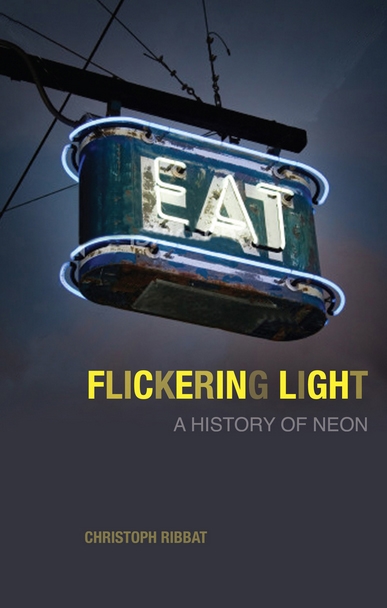‘Jumpin’ Jack Flash, it’s a gas, gas, gas.’ It might be just an association of words that inserted this Rolling Stones lyric into my head while I was reading art historian Christoph Ribbat’s book on the history of neon – neon is essentially a gas-filled flash of light, after all. But there are some attributes applicable to both neon and the Rolling Stones – namely an on-off-on love affair with the public, resulting in a longevity far greater than anyone might have expected. Flickering Light describes not only the commercial development of neon – as advertising and signage – but more interestingly weaves around this its cultural influence as metaphor and inspiration for the writers, artists and musicians who, throughout the twentieth and early-twenty-first centuries, have made reference to it in their work.
Neon gas (one of the ‘noble’ category of gases – odourless, colourless, monatomic) and its characteristic red glow when electrically charged were discovered in 1898 by British chemistry professor William Ramsay and his assistant Morris Travers. But it was business-savvy French chemist and engineer George Claude who saw the potential in the discovery. It was Claude’s experiments in the following decade, including exploring the coloured light properties of other noble gases – the blue produced by argon, for example – and also his idea of mixing gases and coating the light’s glass tubes to create a wider range of colours, that led to his creating and enthusiastically promoting the first commercial neon lights. For such a European invention, it’s somewhat ironic that American cityscapes – New York’s Times Square, known as ‘the Rainbow Ravine’, and Las Vegas, which in the 1960s was described not by its architectural skyline but by its artificial glow – have come to epitomise neon’s often contradictory appeal to artists in all artforms; that is, an ability to embody both the idea of an optimistic urban modernity and its flipside of a darker dystopian underbelly.
Nelson Algren’s 1947 short story collection The Neon Wilderness focuses on the seedy lives of Chicago’s underclass of prostitutes, criminals and alcoholics, played out under the city’s neon glow. At the same time Algren was writing, Laszlo Moholy-Nagy was entranced by the vibrancy of those same Chicago lights, capturing their energy in his experimental, almost abstract photographs.
Among the visual artists who have worked directly with neon, Bruce Nauman is singled out for his philosophical explorations of the meaning of language using flashing texts in works such as Run from Fear, Fun from Rear (1972). In Tracey Emin’s more emotive neon texts, such as You Forgot to Kiss My Soul (2001), shaped in the form of the artist’s own handwriting, the artist’s combination of sexual energy and vulnerability is equated by Ribbat with the brash glare and physical fragility of the glass tubes themselves. All of which is also connected to Emin’s upbringing in Margate, Britain’s own (once- glamorous, now fallen into disrepair) Las Vegas-style resort. For musical references, Ribbat’s examples include Cole Porter’s down-at-heart 1936 song Down in the Depths. Here the excitement of the ‘million neon rainbows’ seen from the windows of a Manhattan high-rise serve only to exag- gerate the contrast with Porter’s own melan- choly state of mind at the time. In Kraftwerk’s song Neonlicht, from their 1978 album Die MenschMaschine, it’s the cool, detached quality of neon rather than its emotive qualities that forms the basis of the metaphor.
The ongoing development of neon lighting technologies in the latter half of the twentieth century – their application in the development of modern plasma displays, for example – isn’t focused on in the latter half of the book. Instead Ribbat finds more examples of how adaptable and pervasive a metaphor neon lighting in its 1930s–60s heyday still is, from the Verve track Neon Wilderness, off their 1996 album Urban Hymns, to David Foster Wallace’s story ‘Good Old Neon’, from his 2004 collection, Oblivion. Newer neon technologies may be subtler, smoother and more efficient, but where’s the edgy attraction or rock ’n’ roll inspiration in that?
This article originally appeared in the September 2013 issue
